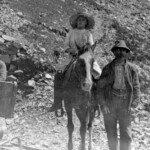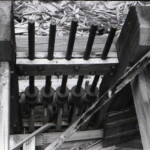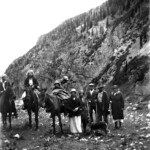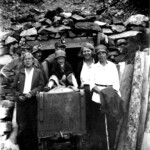The Black Di’Mond Mine is located at an elevation of over 11,000 feet near Diorite peak, overlooking Tomahawk Basin and Basin Creek in La Plata Canyon, Colorado. 37°26’8.08″N, 108° 3’26.04″W
August (Gus) and Charlie Ekburg, his brother were the original Black Di’Mond claim locators and owners; they owned and operated the mine nearly a half century. At times they employed Gus’s son-in-law, Arvid Alexander, another case-hardened Swede, as well as Charlie’s son, Verner when he was of age. Gus’s son-in-law, Arvid Alexander Sr., maintained the claims after Gus’s passing, but never mined ores, according to the Alexander family.
Gus and his brother Charlie were hard-rock miners; in the summer of 1897 they located the White Di’Mond lode claims, some time after they or Gus had located the Black Di’Mond mining claims (we’re assuming). These claims were in the California Mining district, contiguous with the Little Kate vein and near the Tomahawk mine in the Basin Creek basin. The White and Black Di’Mond mine portals day-lighted at over 11,000 feet in elevation near Diorite Peak.
The Ekburg brothers mined a concentration of a gold tellurium mineral, commonly called “gold tellurides” , from the Black Di’Mond vein and intersecting White Di’Mond vein. The gold ore in the Black Di’Mond, had the habit of pinching and swelling as is common in La Plata Mountain gold deposits. Even though gold was the sot-after mineral, the ore contained silver as well.
Prospectors were able to follow the Di’Mond veins on the surface for several thousands of feet along its strike, but they did not necessarily containing valuable minerals. Gus and the Black Di’Mond mine were included in a 1930 U.S. Geologic Survey report Professional Paper 219 by Edwin Eckels.
Family records do not contain specific day-to-day information regarding operations and logistics. Gus ceased mining sometime in the early 40’s(?) This author suspects its closing was due to the government’s ban on gold mining during WWII. Other speculations blame its closing on the 1930’s depression economy or ramping of political unrest in Europe. Or perhaps when the Roosevelt administration established private ownership of gold to be illegal, that too had an impact on the Ekburg’s mining activities.
Gus leased and operated other mines in the area such as the Little Kate and Tomahawk veins when mining was active in the Tomahawk Basin.
Stay tuned, more info and images are available and will appear here once the webmaster processes them.
C. Ekburg
All images copyright Ekburg Family Archive.










